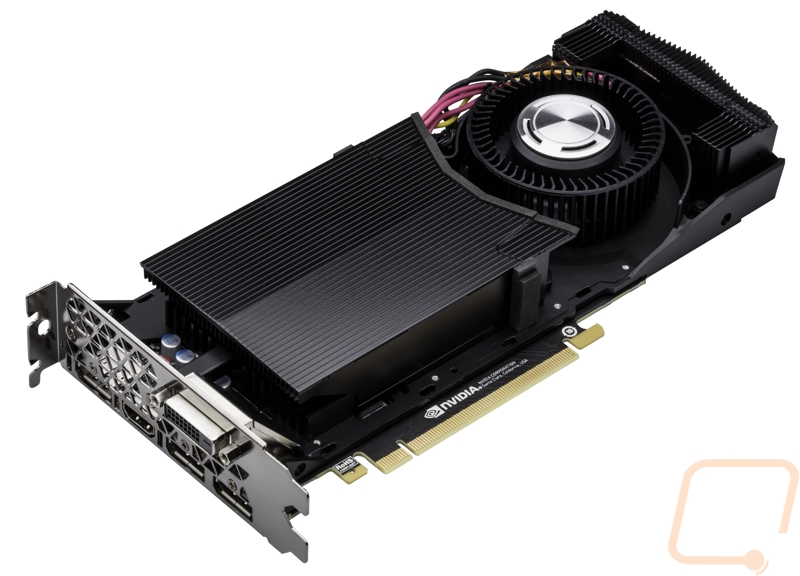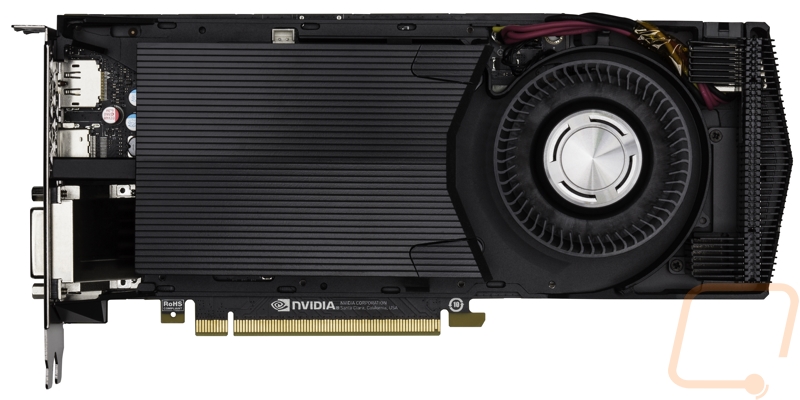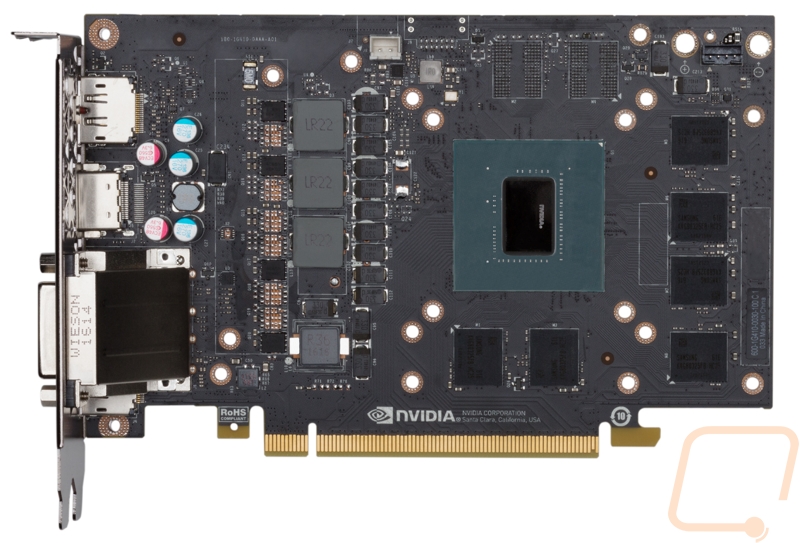Card layout and Photos
With the GTX 1060 Founders Edition Nvidia has stepped out of the norm that we have seen with past generations. Cards like the GTX 960 and the GTX 760 have always had basic plastic coolers on their reference blower designs. Well with Nvidia introducing the Founders Edition cards, we have finally seen them move to an actual metal design, something that costs a little more to manufacture and wouldn’t exactly be an option when you are trying to design the cheapest possible cooler for the card. I think a lot of people had a hard time with the idea of the Founders Edition cards being a “premium” design with the GTX 1070 and GTX 1080. Part of that is because traditionally a reference card is the bottom of the barrel. But also because the Founders Edition cards, while looking good still perform like reference cards. See, the idea is that they cost more because of their all metal construction, thicker and higher quality backplates, etc. But everyone remembers that the last few generations the reference cards had those same features. Aftermarket cards though have been cutting back on the overall build quality with plastic fan shrouds and thin backplates. Well the GTX 1060 is bringing that same construction into a price point that doesn’t normally have higher quality construction.
The GTX 1070 Founders Edition’s overall design tries to emulate the angular design of the higher end cards. They dropped the window that peeks in at the heatsinks and in its place they have a metal panel in all black that gives the same look. The design has a few small intakes but some of them have moved closer to the fan this time around. The GTX 1060 logo is over on the left like the higher end cards and each letter is filled in with a chrome finish as well. The cooler does break out from the shadow of the 1080 a little with a little more black on the shroud that gives a nice contrast to the silver finish around the fan and behind the logo.



As always the cooler design for the Founders Edition is a blower design. This means that it is designed to pull air in the side of the fan and blow it from one end of the card to the other and out the back of your PC. This design is great for smaller cases that don’t have the cooling to help exhaust the heat your video card generates but the overall blower fan takes up space that an aftermarket cooler would use for more heatsink. So being a blower design the top and bottom of the card are both sealed to help it push air out the back of your case, not inside. The end of the 1060 FE does have a heatsink visible but this is a passive cooler to help dissipate a little extra heat, plus it looks great showing on the end of the card.



In the board shots that Nvidia provided with the fan shroud pulled off we can better see how the fan shroud seals around the fan to make sure all of the air blows across the PCB. We can also see that the fake window is actually part of the heatsink itself, not just a fake panel. The heatsink is nearly the length of the short PCB. This gets it directly over the GPU and the power circuitry but only over the bottom two VRAM chips.


While we are looking at the GTX 1060 with the fan shroud off, let's also peek at the PCB without the heatsink. We can see that the power chokes are all over on the left of the GPU. Like normal, the VRAM is placed around the GPU but if you look closely you will see the 6 1-gig chips. But there are two empty spots up top. This does make us wonder if Nvidia was going to go with 8 gigs and decided to drop down to 6 gigs or if maybe they are leaving room to use this same PCB with a later card. This sort of thing happens a lot with a normal card and then a TI card for example. I guess we will have to wait and find out in the future, though.

Up on the top edge, we have two things going on. Like the reference cards for the past few generations and all of the Founders Edition cards with the 1000 series launch. The GTX 1060 Founders Edition has the glowing Geforce GTX logo up on the top edge. I mentioned it in my GTX 1080 review but given the premium price and focus of the Founders Edition cards I would have loved to see them drop the green only color and use RGB lighting to let us pick a color that matches builds. The logo is a little closer to the edge than the previous generations, this is because the silver strip takes up a little more room. What is different with the GTX 1060 though is the lack of any SLI bridges this time around. They decided to drop SLI support at all. This means that in the future 1060 owners will have to sell their card if they are looking for an upgrade. Part of me thinks this is okay, given the price point and the 1080p focus this isn’t really a price point that people are looking to run two cards, but with AMD pushing the Crossfire performance of their RX480 compared to the GTX 1080 it is a little weird that the GTX 1060 doesn’t have it. Another aspect to keep in mind as well is now that we are slowly moving into DX12, DX12 handles multiple cards differently. You might be able to benefit from two cards in DX12 games without SLI support at all.

Normally the power connector doesn’t really have anything interesting going on. The GTX 1060 has a 120 Watt TDP, this is lower than the RX480’[s 150 Watt TDP. They both have 6-pin power connections though the Rx480 has had a bit of drama with power usage over the 6-pin and the PCI Slot. The GTX 1060, however, should be good with just the 6-pin as the lower TDP should keep the power usage within standards assuming Nvidia doesn’t route it all from the PCI slot. What is weird here though is the placement of the connection. Normally in a shorter PCB design like this, the power connection would be at the end of the PCB but in the middle of the top of the cooler. Well, Nvidia wanted to keep the connection down at the end. To do this they have mounted the connection in the end of the fan shroud and then they run wires to the normal power location on the PCB.

Nvidia provided a photo of the inside of the cooler and this photo helps give us a better idea of how they did this. They used six cables running from the PCB around the blower fan, then up under the connection. They wrapped the cables in a protective coating near the heatsink to help protect them from melting. There was some talk on Facebook and again on Reddit about this design. Given the overall quality of the GTX 1060’s Founders Edition cooler, it does seem a little weird to use cables like this. Short of using a longer PCB for no reason other than to run the cables over there, I’m not sure there is another way to do this. So is it worth it? Well someone on my Facebook page mentioned that this design will hurt the possibility of FE cards being used for water cooling. I think that is a fair thing to keep in mind. I personally don’t think many people will be wanting to water cool this card, but if you do want to do that you might need to look at some of the aftermarket cards that maybe have longer PCBs.

For display connections, the GTX 1060 has the same layout as the GTX 1070 and 1080 as well as most of Nvidia’s other cards over the last few years. You get one DVI connection, one HDMI, and three DisplayPort connections. This gives a variety of options and enough connections for a multi-monitor setup. The RX480 reference card dropped the DVI port (though I would expect it to come back with the aftermarket cards) and I think that some people will have an issue with that, especially at this price point. It’s different at 4K and similar resolutions where DVI doesn’t even support that bandwidth, for 1080p a lot of people still use it as their connection of choice. Of course being a blower card the back PCI slot does have a lot of venting, they even slipped in vents between the DVI and DisplayPort connections and tiny slots between each plug as well to get the most airflow possible.

Okay, so the back of the GTX 1060 has a few things going on. For starters, we can get a much better look at the shorter PCB and the back of the extended cooler. The back of the coolers that extend out past the end of a PCB like this are always a bit of a variable. Some will have a small hole where the intake fan can pull in more air from the back. Others seem a little unfinished with heatsinks exposed. Others will fill the space in with a small plastic panel. Nvidia went with the fill in panel idea but they didn’t use plastic. Like the rest of the Founders Edition cooler, the small back panel is all metal. In fact, it has the same grooved design in it that the full length back panels on the GTX 1080 and 1070 have. Sadly, with this being a lower price point card they didn’t run the back panel all the way across the back. This does, however, give us a peek at the black PCB. There is a clear difference in the solder points for the pigtail design power extender over what we would normally see with anon PCB connection. The connections are much smaller than the solid wire connections that normally connect the power plugs to a PCB. Part of this might just be not having to support someone pushing hard on the connection anymore, though.



